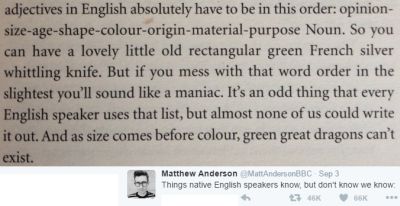Sales Qualification Lesson From Grammar Adjective Order
Back To School week across the Northern Hemisphere. So time for a Sales lesson via the classroom. An English grammar rule is the order of the selling day.
This comes to prominence after a pic multi-retweet captioned Things native English speakers know, but don’t know we know:

Could you have explained this crucial ordering?
It is appears intrinsic enough that The British Council promote it. Albeit with a slightly altered pattern.
There may be two types of Opinion. Age and Shape transposed. Synonymous Origin/Nationality. Purpose strangely omitted.
Who knew that a lovely little old rectangular green French silver whittling knife could give a sales grounding?
Most, nearly all, salesteams focus on one single over-riding qualification factor. Typically a crude measure. Entry-level thinking.
Is it though, deserving of its prominence? Is it really the first thing to look at? Is it the prime filter by which to view each and every possible sale?
In reality, I feel such trait is only an initial pointer to deal success. You usually need more.
Note grammar complexity; “It is very unusual to have more than three adjectives.”
Have you an ideal deal trio?
And are they mere numbers? Or something of more prescient substance? (For instance, do you utilise the power of demo- and psycho-graphics?)
All in the right ascending order too. A further point about adjective ranking is that the farther up the scale, the more difficult it is to change. A solid link with bid suitability here. That Go/No decision can be so critical – a bit like the fabled back-of-an-envelope sketch being the cheapest yet most costly element of design. As the farther down you travel, the less you can compensate for a misplaced trait earlier.

